Nestled in the heart of Pampanga's rich culinary heritage, Filipino Tamales (Kapampangan Boboto) is a luxurious blend of rice flour and coconut milk, layered with savory meats and eggs, wrapped in aromatic banana leaves.
This cherished recipe, passed down through generations, transforms simple ingredients into an extraordinary dish that captures the essence of Filipino celebration, particularly beloved during Christmas season after Simbang Gabi (dawn mass).
What is Boboto?
Kapampangan Tamales (Boboto) is a time-honored delicacy from Pampanga that features a ground rice and coconut milk base, distinctively presented in white and red layers, filled with a luxurious combination of shredded chicken, ham, shrimp, and eggs. Each portion is meticulously wrapped in banana leaves, which impart an unmistakable aroma during the steaming process. This complete meal exemplifies the sophisticated culinary heritage of Pampanga, with its name "Boboto" (meaning "to vote") stemming from the historical practice of women preparing the dish while men participated in local elections.
Jump to:
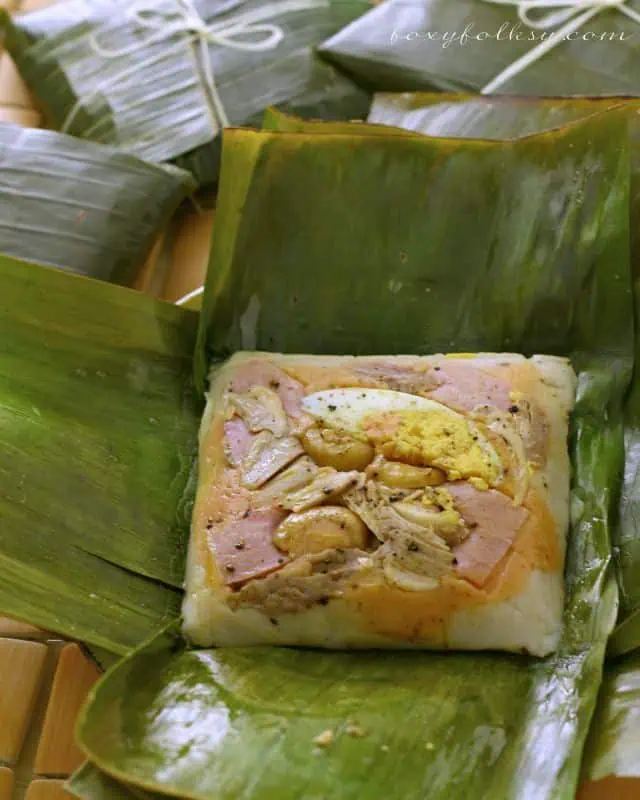
Why You'll Love This Recipe
- Authentic Kapampangan recipe passed down through generations
- Perfect blend of savory and slightly sweet flavors
- Makes an impressive breakfast or dinner option
- Can be prepared ahead for special occasions
- Fragrant banana leaf wrapping adds unique aroma
- Versatile recipe that allows for personalization
- Rich in cultural history and tradition
Ingredients
These ingredients were chosen to create an authentic Filipino tamales experience that balances flavor, texture, and tradition. Rice forms the starchy base when ground into powder, while coconut milk adds creaminess and tropical flavor essential to Filipino cuisine. Brown sugar provides subtle sweetness that complements the savory elements. Roasted peanuts add nutty depth and texture.
The combination of chicken, ham, shrimp, and eggs creates a luxurious protein-rich filling typical of special occasion dishes in Pampanga. Banana leaves aren't just practical wrappers, they infuse the entire dish with a distinct aroma impossible to achieve any other way.
Atsuete (annatto) provides the traditional red-orange color that makes boboto visually distinctive and appealing, reflecting the care and artistry behind this beloved cultural treasure.
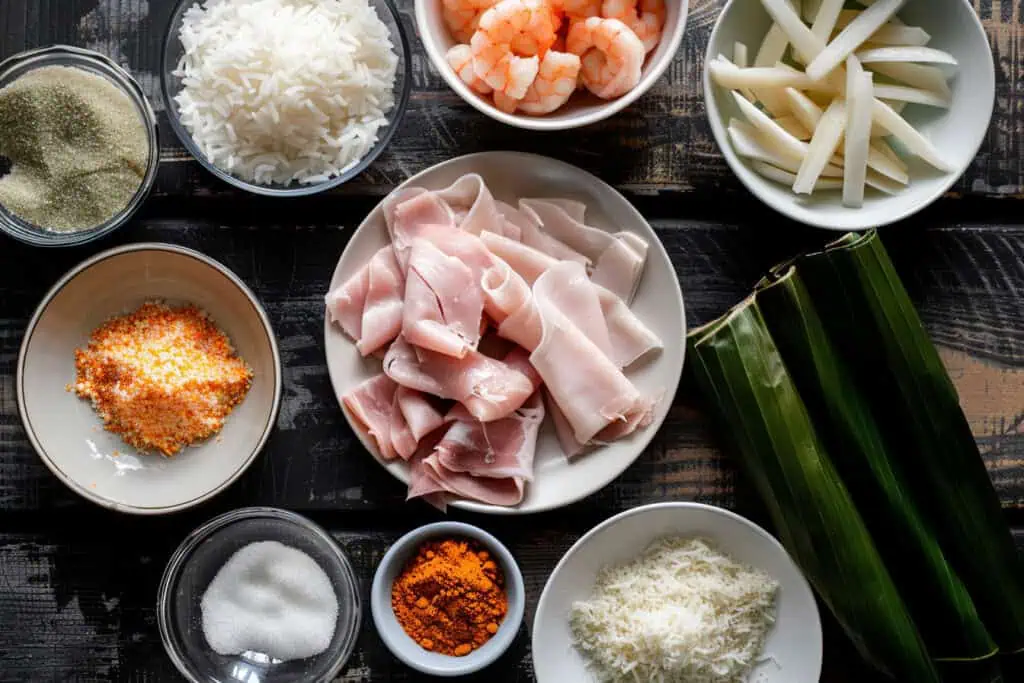
For the Base:
- 3 cups rice
- 5 cups coconut milk
- 1 cup brown sugar
- 1 cup roasted peanuts
- Salt and pepper to taste
For the Filling:
- ½ cup shredded chicken
- ½ cup sliced ham
- ½ cup shelled shrimp
- 2 boiled or salted eggs, sliced
For the Coloring and Wrapping:
- Atsuete powder dissolved in ½ cup water for red coloring
- Banana leaves, wilted
For Toppings:
- Toasted garlic
- Toasted nuts
- Thickened coconut milk sauce
Equipment
- Large steamer (Kawa/Caldera) - For cooking the wrapped tamales, ensuring even heat distribution
- Food processor or blender - Essential for grinding rice and peanuts into the fine powder needed for the proper texture
- Large shallow pot (Kawali) - The wide surface area helps with even cooking and faster evaporation when preparing the rice paste mixture
- Mixing bowls - For separating and preparing the white and red mixtures
- Measuring cups and spoons - Ensures precise ingredient amounts for consistent results
- Kitchen twine (Tali) - Secures the banana leaf wrappings during steaming to prevent leakage
- Wooden spoon (Sandok) - Perfect for the continuous stirring required to achieve the right consistency
- Strainer (Salaan) - Used when preparing the atsuete solution for the red coloring
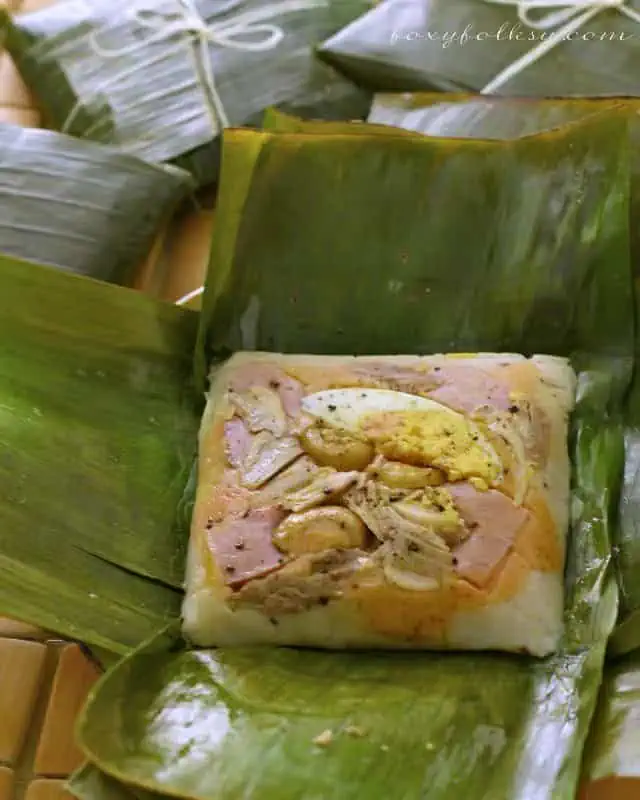
How To Make
- Toast the rice in a large pan over medium-low heat, stirring constantly until it turns golden brown. Grind the toasted rice in a food processor until it becomes very fine like powder. Do the same with the roasted peanuts and set both aside.
- Prepare the base mixture by heating coconut milk in a shallow pot over medium heat. Add salt, pepper, and brown sugar. Once it starts to gently boil, gradually add the ground rice while stirring continuously. Add the ground peanuts and keep stirring until the mixture becomes thick and starts pulling away from the sides of the pot, about 15-20 minutes.
- Create the two-colored bases by taking three-quarters of this mixture out and putting it in a bowl - this is your white base. With the remaining quarter in the pot, add the atsuete water and cook for 5 more minutes until it turns red-orange.
- Prepare your banana leaves by quickly passing them over low heat until they become soft and bendable. Wipe them clean and cut into 12x12 inch squares. Use two leaves for each tamales.
- Assemble the tamales by putting ¼ cup of the white mixture in the center of your banana leaves and flattening it into a square. Add your toppings: shredded chicken, sliced ham, boiled or salted eggs, and shrimp. Cover everything with 2 tablespoons of the red mixture.
- Wrap properly by folding the banana leaves to make a neat package and tie with string in both directions so nothing leaks out while cooking.
- Steam until cooked by filling your steamer with water and bringing to a boil. Place your wrapped tamales in the steamer, ensuring they're not too crowded. Steam for 20-30 minutes until fully cooked.
- Prepare the sauce by simply heating some coconut milk in a pan, stirring until it thickens. Let tamales rest for 5 minutes after cooking, then serve hot with toasted garlic and nuts on top. Pour the thickened coconut milk sauce over if desired.

Tips from Lola's Kitchen
- Toast rice properly - Continue toasting until you smell a nutty aroma, which indicates it's ready. This develops a deeper flavor profile.
- Master the stirring technique - Keep stirring the mixture constantly in one direction to avoid lumps and ensure even cooking.
- Perfect banana leaf preparation - Leaves should be heated just enough to be pliable but not burnt. Too much heat will make them brittle.
- Fresh ingredients matter - Use freshly extracted coconut milk for the richest flavor and creamiest texture.
- Mind your measurements - The ratio of rice to liquid is crucial; measure ingredients precisely for best results.
- Test for doneness - The mixture is ready when it pulls away from the sides of the pot and holds its shape when scooped.
- Allow resting time - Let tamales rest for 5 minutes after steaming to allow flavors to settle and make unwrapping easier.
- Wrap tightly - Ensure no gaps in wrapping to prevent the mixture from leaking during steaming.
Substitutions
- Rice - Can use glutinous rice flour instead of grinding your own rice, though the texture will be slightly different
- Coconut milk - Evaporated milk can work in a pinch, but will produce a less authentic flavor
- Atsuete powder - Natural food coloring or a small amount of paprika can substitute for color
- Banana leaves - Parchment paper can be used as an emergency substitute, though you'll lose the distinctive aroma
- Fillings - Feel free to adjust the protein mix based on availability; all chicken or all seafood works well
- Brown sugar - White sugar or palm sugar can be substituted, adjusting for sweetness as needed
- Peanuts - Cashews can substitute for a different but complementary flavor profile
Troubleshooting
- Mixture too dry - Add coconut milk gradually, one tablespoon at a time, until reaching desired consistency
- Mixture too wet - Continue cooking longer, stirring constantly until excess moisture evaporates
- Banana leaves breaking - Heat leaves more gradually and handle gently; use two leaves for extra strength
- Filling falling apart - Ensure proper wrapping technique with tight folds and secure ties in both directions
- Uneven cooking - Make sure tamales are placed with space between them in the steamer for even heat circulation
- Tamales unwrapping during steaming - Double-check your tying technique and use more string if needed
- Rice not fine enough - Pulse longer in food processor, or sift and re-process coarser particles
Storage & Reheating
Storage:
- Refrigeration - Store wrapped tamales in an airtight container for up to 3 days
- Freezing - Wrap individual tamales in plastic wrap then aluminum foil and freeze for up to 1 month
- Sauce storage - Store extra coconut milk sauce separately in the refrigerator for up to 2 days
Reheating:
- Steaming (preferred) - Steam frozen or refrigerated tamales for 10-15 minutes until heated through
- Microwave - Cover with a damp paper towel and microwave for 1-2 minutes, checking halfway through
- Pan method - For a crispy variation, unwrap and lightly pan-fry slices of tamales after steaming

FAQ
Can I make this ahead of time?
Yes, you can prepare the tamales up to 24 hours ahead and keep them refrigerated. Steam just before serving for the best texture and flavor.
Why is my mixture not thickening?
Continue cooking and stirring until moisture evaporates. The mixture should have a thick, paste-like consistency that holds its shape. Using the right ratio of rice powder to liquid is crucial.
How do I know when the tamales are fully cooked?
Tamales should feel firm when pressed gently through the wrapper. The banana leaf should also have darkened slightly, and you should smell the distinctive aroma of the cooked rice and coconut mixture.
Can I freeze uncooked tamales?
Not recommended. The rice mixture may separate and lose its texture. It's best to cook them completely before freezing.
How can I make this more healthy?
You can reduce the sugar content, use leaner proteins like chicken breast, and add more vegetables to the filling such as carrots or bell peppers.
What's the best way to serve Boboto?
Serve hot with additional coconut milk sauce on the side. It pairs beautifully with coffee or hot chocolate for breakfast, or as a special main dish with a side of garlic rice.
Can I make a vegetarian version?
Absolutely! Replace the meat with a combination of sautéed mushrooms, tofu, and vegetables like carrots and green peas for a delicious vegetarian alternative.
Why are my banana leaves turning black?
This is normal! The heat causes the chlorophyll to break down, resulting in a darker color. As long as they're not burnt or brittle before wrapping, this is perfectly fine.
Related
Looking for other recipes like this? Try these:
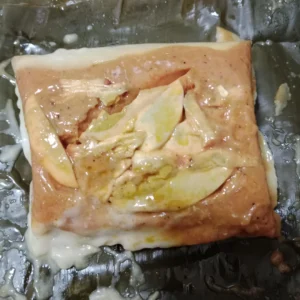
Filipino Tamales (Kapampangan Boboto)
Equipment
- Large steamer (Kawa/Caldera) For cooking the wrapped tamales
- Food processor or blender For grinding rice and peanuts into fine powder
- Large shallow pot (Kawali) For cooking the rice paste mixture
- Mixing bowls For separating white and red mixtures
- Measuring cups and spoons For precise ingredient portions
- Kitchen twine (Tali) For securing banana leaf wrappings
- Wooden spoon (sandok) For continuous stirring of mixture
- Strainer [Salaan] For atsuete preparation
Ingredients
For the Base:
- 3 cups rice bigas
- 5 cups coconut milk gata
- 1 cup brown sugar maskada
- 1 cup roasted peanuts mani
- Salt and pepper to taste
For the Filling:
- ½ cup shredded chicken piniraso na manok
- ½ cup sliced ham
- ½ cup shelled shrimp hipon
- 2 boiled or salted eggs sliced (itlog na maalat)
For the Coloring and Wrapping:
- Atsuete powder dissolved in ½ cup water for red coloring
- Banana leaves wilted (dahon ng saging)
For Toppings:
- Toasted garlic sinangag na bawang
- Toasted nuts sinangag na mani
- Thickened coconut milk sauce sarsa ng gata
Instructions
- Toast the rice in a large pan over medium-low heat, stirring constantly until it turns golden brown. Grind the toasted rice in a food processor until it becomes very fine like powder. Do the same with the roasted peanuts and set both aside.
- Heat coconut milk in a shallow pot over medium heat. Add salt, pepper, and brown sugar. Once it starts to gently boil, gradually add the ground rice while stirring continuously. Add the ground peanuts and keep stirring until the mixture becomes thick and starts pulling away from the sides of the pot, about 15-20 minutes.
- Take three-quarters of this mixture out and put it in a bowl - this is your white base. With the remaining quarter in the pot, add the atsuete water and cook for 5 more minutes until it turns red-orange.
- Prepare your banana leaves by quickly passing them over low heat until they become soft and bendable. Wipe them clean and cut into 12x12 inch squares. Use two leaves for each tamales.
- To assemble, put ¼ cup of the white mixture in the center of your banana leaves and flatten it into a square. Add your toppings: shredded chicken, sliced ham, boiled or salted eggs, and shrimp. Cover everything with 2 tablespoons of the red mixture.
- Fold the banana leaves to make a neat package and tie with string in both directions so nothing leaks out while cooking.
- Fill your steamer with water and bring to a boil. Place your wrapped tamales in the steamer, making sure they're not too crowded. Steam for 20-30 minutes until fully cooked.
- For extra sauce, simply heat some coconut milk in a pan, stirring until it thickens. Let tamales rest for 5 minutes after cooking, then serve hot with toasted garlic and nuts on top. Pour the thickened coconut milk sauce over if desired.
Tips from Lola's Kitchen
- Toast rice until you smell a nutty aroma
- Keep stirring the mixture constantly to avoid lumps
- Banana leaves should be heated just enough to be pliable
- Use fresh coconut milk for best results
- Let tamales rest for 5 minutes after steaming
Nutrition
Traditional Serving Suggestions
- Served hot for breakfast with coffee or hot chocolate
- Perfect companion for Simbang Gabi (night mass)
- Can be paired with garlic rice for a complete meal
- Best enjoyed with additional coconut milk sauce
Troubleshooting
- Mixture too dry: Add coconut milk gradually
- Mixture too wet: Cook longer until it reaches paste consistency
- Banana leaves breaking: Heat leaves more gradually
- Filling falling apart: Ensure proper wrapping technique
Ingredient Alternatives
- Rice: Can use glutinous rice flour
- Coconut milk: Evaporated milk (less traditional)
- Atsuete: Food coloring (if unavailable)
- Banana leaves: Parchment paper (emergency substitute)
Storage & Reheating
- Storage:
- Refrigerate up to 3 days
- Freeze up to 1 month
- Reheating:
- Steam for 10 minutes
- Microwave: 1-2 minutes with damp cloth
Variations
- seafood Tamales: Use all seafood filling
- Vegetarian: Replace meat with mushrooms and tofu
- Spicy: Add chopped chilies to filling
- Sweet: Increase sugar for dessert version
Frequently Asked Questions
Q: Can I make this ahead? A: Yes, prepare up to 24 hours ahead and steam before serving.
Q: Why is my mixture not thickening? A: Continue cooking and stirring until moisture evaporates.
Q: How do I know when it's fully cooked? A: Tamales should feel firm when pressed gently.
Q: Can I freeze uncooked tamales? A: Not recommended. Freeze only after cooking.
The Story Behind Filipino Tamales (Kapampangan Boboto)
Growing up in the culinary capital of the Philippines, every Kapampangan knows that Tamales, or "Boboto" as we lovingly call it, tells a story far deeper than its aromatic banana leaf wrapper suggests. While many might assume this dish shares only its name with Mexican tamales, its journey to Philippine shores reveals a fascinating chapter in our culinary history, dating back to the Manila-Acapulco Galleon Trade of the 16th to 19th centuries.
During this era of maritime commerce, Mexican ingredients and cooking techniques made their way across the Pacific, finding a unique home in Pampanga's sophisticated food culture. However, true to the innovative spirit of Kapampangan cooks, our version of tamales evolved into something distinctly our own. Unlike its Mexican counterpart made with corn masa, Kapampangan tamales embraces our archipelago's abundance of rice and coconut, creating a smoother, more delicate base that perfectly complements our tropical ingredients.
The name "Boboto," meaning "to vote" in Kapampangan, carries its own historical significance. Local folklore tells of women gathering in homes during election days, while men went out to cast their votes. These gatherings became impromptu cooking sessions where the ladies would prepare this labor-intensive delicacy, transforming a political activity into a celebration of community and culinary artistry. This tradition showcases how deeply food is woven into the fabric of Kapampangan social life.
Today, Boboto holds a special place in Pampanga's Christmas celebrations, particularly in the historic town of Bacolor. As dawn breaks during Simbang Gabi (night mass), the streets come alive with the scent of banana leaves and steaming tamales. Local vendors set up their stalls near church entrances, offering this hearty breakfast to parishioners who have just completed their morning prayers. This practice has become so ingrained that many consider their Simbang Gabi incomplete without enjoying a warm package of tamales afterward.
What makes Kapampangan tamales truly special is its layered presentation – a white base crowned with a vibrant red atsuete-tinted topping, symbolizing the meticulous attention to detail that Kapampangan cooking is famous for. Each ingredient, from the hand-ground rice to the precisely measured coconut milk, reflects generations of kitchen wisdom passed down through families. The inclusion of both land and sea flavors – chicken, pork, and shrimp – speaks to Pampanga's geographical blessing of having access to both farm-fresh and maritime ingredients.
In modern Filipino cuisine, where convenience often trumps tradition, Kapampangan tamales stands as a testament to our commitment to preserving culinary heritage. Whether enjoyed as breakfast fare or served at important family gatherings, each bite connects us to a rich history of cultural exchange, community bonds, and culinary excellence that defines not just Pampanga, but the very essence of Filipino food culture.
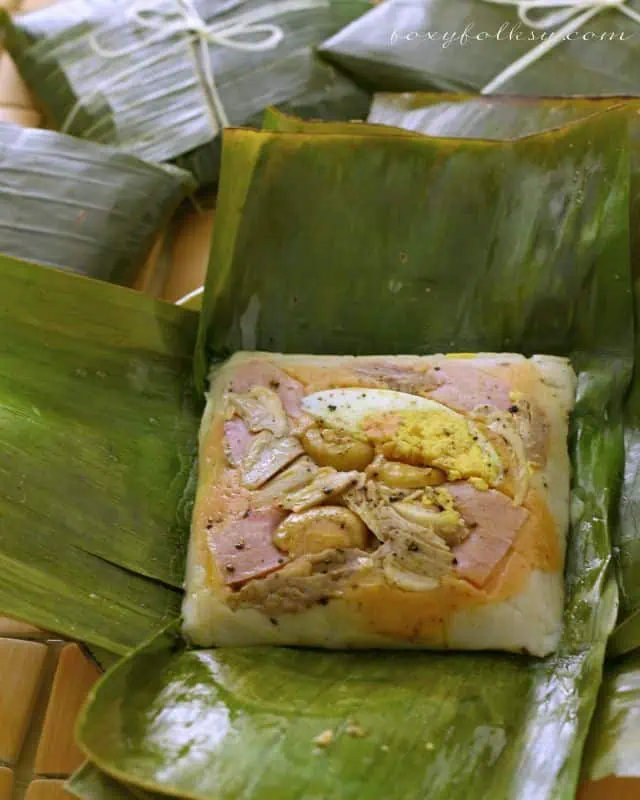







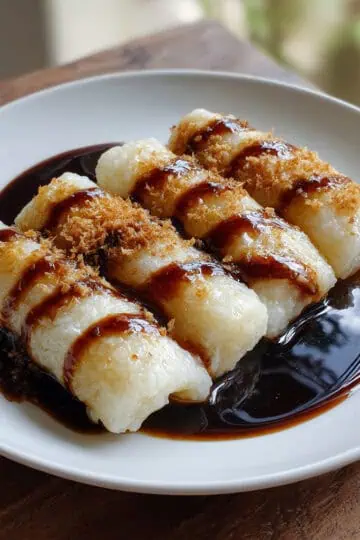
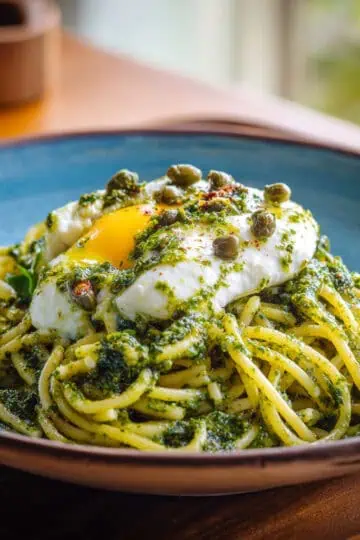
Comments
No Comments